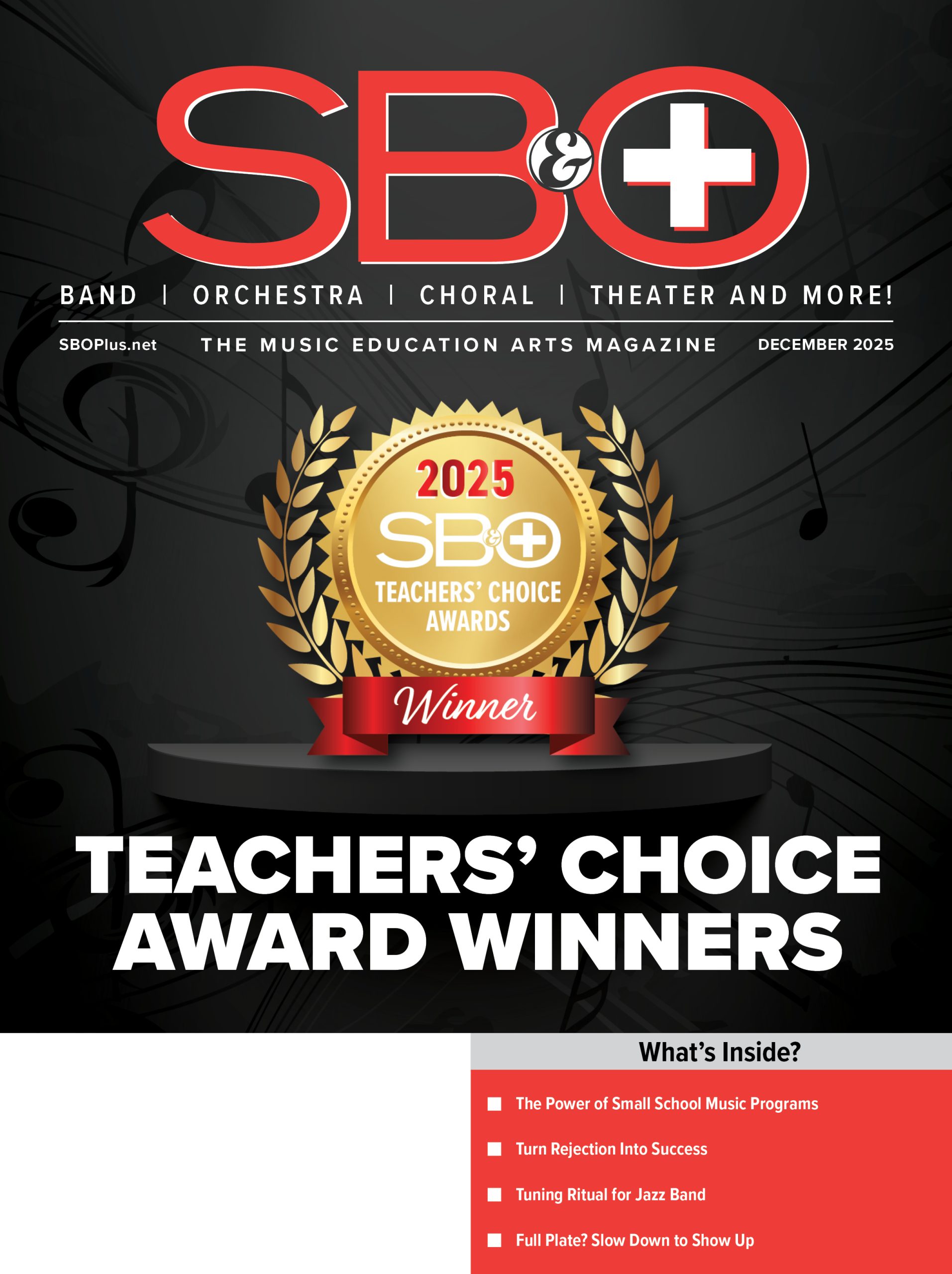 As the fall semester draws to an end, many students and directors are turning their musical efforts to the preparations necessary for concert festival and solo and ensemble contests. In the coming months, many groups and individual young people will perform for mysterious people who are busy scribbling furiously on adjudication sheets.
As the fall semester draws to an end, many students and directors are turning their musical efforts to the preparations necessary for concert festival and solo and ensemble contests. In the coming months, many groups and individual young people will perform for mysterious people who are busy scribbling furiously on adjudication sheets.
Who are these people, what are they thinking, and—most importantly—how do you get a “one?” This article will do its level best to help answer all of those questions. While this author is an experienced solo and ensemble adjudicator and the article is tilted in that direction, it is hoped that some of these insights and suggestions will be applicable to the large ensemble, as well.
In preparing for the solo and ensemble contest, a very important issue arises first: What should I play? As a judge who has listened to far too many renditions of “The Theme from Pokemon,” it is important that the student is aided in their selection of music. The goal of the solo and ensemble contest is individual growth for the students involved. With that in mind, the student should be led towards a piece that offers challenges that they can reasonably overcome in the allotted preparation time. Many excellent music lists exist (such as Texas’s UIL Prescribed Music List), and they should be consulted, even if your state does not regularly make use of such a resource. When in doubt, ask a specialist.
As far as musical preparation goes, it may be helpful to take a look at the various categories that the student will be assessed on during the contest. The majority of locales utilize some sort of rubric for their solo and ensemble judges, and many of them throughout the country look quite similar. They generally address six wide musical categories: tone quality, intonation, rhythm, technical facility, musical effect, and articulation. Each of these will be addressed in turn, below.
The first category, tone quality, is often the most evident, both to the musical and nonmusical auditor. The differences between a good and bad sound however, can often be said to hold to the old adage “I know it when I hear it.” However, that isn’t very useful for the developing student. Instead, the entire matter can be boiled down to one question: Is this a characteristic sound on this particular instrument?
Many problems with tone quality (and, indeed, many other performance problems), stem from the fact that students, very often, do not know what their own instrument is supposed to sound like. That can be very surprising for those of us who have been submerged in music for two, three, four, or more decades, but these young students must be given great examples. While it is always helpful for band/orchestra directors to demonstrate excellent sounds on each instrument, it is very often a bit of a stretch, even for the most diligent doublers. Instead, we should always lean on the technology that is so readily at our disposal.
This author advocates creating a mix cd or online playlist for each performer, with several artist-level performers of their instrument from the first week of beginning classes. From there, the teacher should introduce more names and recordings to the students, so that they will understand and assimilate what it is to truly sound like a saxophone, or a tuba, or a viola, etc. As we all know, YouTube is full of both wonderful and hideous examples, and students may just find exactly the wrong sounds when left to their own devices.
Many musical factors fall under the umbrella of tone quality, but many adjudicators will focus on the overall beauty of the sound. Is the tone shrill, tubby, or just right? Is the sound uneven or even throughout the tessitura? Does tonal quality change during crescendos or decrescendos? Is there excessive “noise” in the sound?
Coequal with tonal beauty in the ears of nearly all listeners is intonation. While we must often talk about them separately, it is hard to divorce them in practice. If a student has an abstractly beautiful sound, but intonation swings wildly throughout registers or between notes, the overall effect is of an unpleasant aural sensation. Call it personal preference, but intonation is incredibly important to this author, as a judge.
It is important for students to utilize an accompaniment of some type in accompanied pieces, even if the rules of your particular solo/ ensemble contest do not dictate it as being necessary. Students should perform solos as often as possible with either a pianist or the backing CD now available with most standard solo collections when a pianist is not available. The ability to listen to and play against a fixed pitch-source is invaluable to the development of the performer tonally, intonationally, and rhythmically. The student, with proper guidance, will learn to adjust as well they must, and their sounds will improve and grow more resonant as a result.
Even when the chosen solo is without accompaniment, however, the student must be given to understand that the rules of intonation ALWAYS apply. No instrument—no matter how pricey—is “tuned at the factory.” Every wind and string instrument has its own peculiarities that must be learned and accounted for.
The next category, rhythm, might seem to be fairly straight-ahead, but students often exhibit varying problems in this area. Of paramount importance, of course, is the performance of notes and rests in the appropriate rhythmic values with a steady pulse: Easier said than done for many students. Perhaps the best piece of advice that can be offered in this area is the vital importance to every musician of using a metronome constantly, from the very first stage of learning a piece of music to the very last. This is not an option. So many future problems can be resolved before they even occur when the metronome is used properly by the student.
While most problems with rhythm will be eliminated if the student is shown how to properly use the metronome in their practicing (and if they actually do it), some other concerns in this area must be addressed. It is important for students to not pulse every note that they play. Many young performers play every solo as if it were a march; instead, while keeping a steady, clear pulse, they should be shown where accents are and are not appropriate in a piece. Also, students should be dissuaded from performing a solo either faster or slower than written. Too slow, and perhaps a slightly easier piece would have been a better choice; too fast, even when the student is capable, sounds gauche, as if the performer thinks they know better than the composer.
Technique is a very wide category, indeed. One of the most obvious concerns found in this caption is the performance of the correct notes, printed in the part. While note mistakes are easy to hear and, of course, points are prodigiously docked for such instances, there are many more musical concerns that fall under this area.
Some of the other problems addressed in this category include the proper performance of markings: Does the student know the difference between an agogic accent, a marcato accent, a staccato, and a tenuto? Is there an audible difference between all of these? Are all of the attacks and releases performed accurately and musically? Despite adherence to rhythmic guidelines, does the style seem overly labored or frenetic?
Again, musicianship is, perhaps, an overly wide category. Points in this caption, however, are usually deducted for one of a few different problems. First of all is phrasing: Most simply, is the student breathing in appropriate spots with the appropriate sort of release and attack? Are they observing the natural accents implied by the musical structure?
Next comes the all-important matter of dynamics. To be blunt, most students simply do not perform with the appropriate level of dynamic contrast. At best, many play with a dialectic, two-color approach between loud and soft. Instead, they should understand that there is a whole wealth of dynamic contrast and color available to them. Along with this is the matter of the crescendo and decrescendo: Both should be performed gradually and fluidly.
Last in our list of musical concerns is articulation. Along with the concerns about accents listed in the technique section above, the basic attack of each performer should be addressed. Is it too raspy, unclear, is there excess noise involved, etc.? While articulation problems certainly differ by instrument and concerns should be addressed on a case-by-case basis, the need exists for every instrument for a ready, clear articulation free of unwanted sound.
In addition to all of the musical considerations listed above, many adjudication sheets include an “other” category. This is a chance for the judge to voice any concerns not directly related to the performance. For example, the chosen music may be too hard or too easy, the student may have been dressed inappropriately for the event, their posture may be off, they may have made a disappointed facial expression every time they missed a note, etc. This simply is a reminder that there is much more to every performance than the music performed.
It is hoped that these thoughts and suggestions will offer help to those preparing for contests. At its heart, the solo and ensemble festival is a great tool for musical and technical growth for individual students. I, for one, am looking forward to hearing many wonderful performances in the coming months!
Dr. Andrew J. Allen is an assistant professor of music at Midwestern State University. As a concert saxophonist, he has performed throughout the United States and Europe, commissioning and premiering nearly twenty new works for his instrument. In addition, he is a leading scholar of the saxophone, with articles published in The Saxophone Symposium, Saxophone Today, The Instrumentalist, and School Band and Orchestra, among other publications. This February, he will be presenting a clinic at the Texas Music Educators’ Association Conference.






















